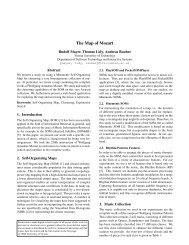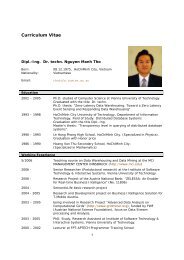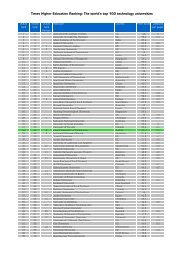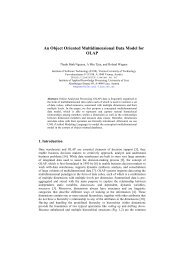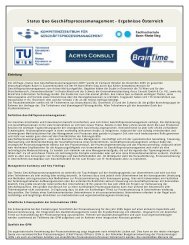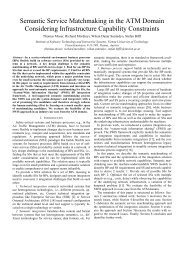Using Psycho-Acoustic Models and Self-Organizing Maps to Create ...
Using Psycho-Acoustic Models and Self-Organizing Maps to Create ...
Using Psycho-Acoustic Models and Self-Organizing Maps to Create ...
You also want an ePaper? Increase the reach of your titles
YUMPU automatically turns print PDFs into web optimized ePapers that Google loves.
‘<br />
‘<br />
—<br />
<strong>Using</strong> <strong>Psycho</strong>-<strong>Acoustic</strong> <strong>Models</strong> <strong>and</strong> ¢¡¤£¦¥ <strong>to</strong> create a Hierarchical Structuring of Music<br />
available as MIDI. A more readily available format is the raw audio<br />
signal <strong>to</strong> which all other audio formats can be decoded. One of the<br />
first audio retrieval approaches dealing with music was presented<br />
in [35], where attributes such as the pitch, loudness, brightness <strong>and</strong><br />
b<strong>and</strong>width of speech <strong>and</strong> individual musical notes were analyzed.<br />
Several overviews of systems based on the raw audio data have been<br />
presented, e.g. [9, 18]. However, most of these systems do not treat<br />
content-based music retrieval in detail, but mainly focus on speech<br />
or partly-speech audio data, with one of the few exceptions being<br />
presented in [17], using hummed queries against an MP3 archive<br />
for melody-based retrieval.<br />
Furthermore, only few approaches in the area of content-based music<br />
analysis have utilized the framework of psychoacoustics. <strong>Psycho</strong>acoustics<br />
deals with the relationship of physical sounds <strong>and</strong> the human<br />
brain’s interpretation of them, cf. [37]. One of the first exceptions<br />
was [8], where psychoacoustic models are used <strong>to</strong> describe the similarity<br />
of instrumental sounds. The approach was demonstrated using<br />
a collection of about 100 instruments, which were organized using<br />
a `._$©r$ea \ oRg¢t$Agojbv:w in a similar way as presented in this paper.<br />
For each instrument a 300 milliseconds sound was analyzed <strong>and</strong><br />
steady state sounds with a duration of 6 milliseconds were extracted.<br />
These steady state sounds can be regarded as the smallest possible<br />
building blocks of music. A model of the human perceptual behavior<br />
of music using psychoacoustic findings was presented in [30]<br />
<strong>to</strong>gether with methods <strong>to</strong> compute the similarity of two pieces of<br />
music. A more practical approach <strong>to</strong> the <strong>to</strong>pic was presented in [33]<br />
where music given as raw audio is classified in<strong>to</strong> genres based on<br />
musical surface <strong>and</strong> rhythm features. The features are similar <strong>to</strong><br />
the rhythm patterns we extract, the main difference being that we<br />
analyze them separately in 20 frequency b<strong>and</strong>s.<br />
Our work is based on first experiments reported in [26]. In particular<br />
we have redesigned the feature extraction process using psychoacoustic<br />
models. Additionally, by using a hierarchical extension of<br />
the neural network for data clustering we are able <strong>to</strong> detect the<br />
hierarchical structure within our archive.<br />
3. FEATURE EXTRACTION<br />
The architecture of the `Fa0bc_d system may be divided in<strong>to</strong> 3<br />
stages as depicted in Figure 1. Digitized music in good sound quality<br />
(44kHz, stereo) with a duration of one minute is represented<br />
by approximately 10MB of data in its raw format describing the<br />
physical properties of the acoustical waves we hear. In a preprocessing<br />
stage, the audio signal is transformed, down-sampled <strong>and</strong><br />
split in<strong>to</strong> individual segments (steps P1 <strong>to</strong> P3). We then extract features<br />
which are robust <strong>to</strong>wards non-perceptive variations <strong>and</strong> on the<br />
other h<strong>and</strong> resemble characteristics which are critical <strong>to</strong> our hearing<br />
sensation, i.e. rhythm patterns in various frequency b<strong>and</strong>s. The<br />
feature extraction stage can be divided in<strong>to</strong> two subsections, consisting<br />
of the extraction of the specific loudness sensation expressed in<br />
`'g._ (steps S1 <strong>to</strong> S6), as well as the conversion in<strong>to</strong> time-invariant<br />
frequency-specific rhythm patterns (step R1 <strong>to</strong> R3). Finally, the data<br />
may be optionally converted, before being organized in<strong>to</strong> clusters in<br />
steps A1 <strong>to</strong> A3 using the mNp{`Fa0b . The feature extraction steps are<br />
further detailed in the following subsections, with the clustering procedure<br />
being described in Section 4, with the visualization metaphor<br />
being only <strong>to</strong>uched upon briefly due <strong>to</strong> space considerations.<br />
3.1 Preprocessing<br />
€ ) The pieces of music may be given in any audio file format,<br />
(<br />
such as e.g. MP3 files. We first decode these <strong>to</strong> the ‚ [ © $_ƒ¨0iR_<br />
raw<br />
[ ©~g (PCM) audio format.<br />
bvi<br />
) The raw audio format of music in good quality requires huge<br />
(…„<br />
amounts of s<strong>to</strong>rage. As humans can easily identify the genre of a<br />
piece of music even if its sound quality is rather poor we can safely<br />
reduce the quality of the audio signal. Thus, stereo sound quality<br />
is first reduced <strong>to</strong> mono <strong>and</strong> the signal is then down-sampled from<br />
F<br />
e<br />
a<br />
t<br />
u<br />
r<br />
e<br />
E<br />
x<br />
t<br />
r<br />
a<br />
c<br />
t<br />
i<br />
o<br />
n<br />
Preprocessing<br />
Specific<br />
Loudness<br />
Sensation<br />
(Sone)<br />
Rhythm<br />
Patterns<br />
per<br />
Frequency<br />
B<strong>and</strong><br />
Analysis<br />
P1: Audio -> PCM<br />
P2: Stereo -> Mono, 44kHz->11kHz<br />
P3: music -> segments<br />
S1: Power Spectrum<br />
S2: Critical B<strong>and</strong>s<br />
S3: Spectral Masking<br />
S4:Decibel - dB-SPL<br />
S5: Phon: Equal Loudness<br />
S6: Sone: Specific Loudness Sens.<br />
R1: Modulation Amplitude<br />
R2: Fluctuation Strength<br />
R3: Modified Fluctuation Strength<br />
A1: Median vec<strong>to</strong>r (opt.)<br />
A2: Dimension Reduction (opt.)<br />
A3: GHSOM Clustering<br />
Visualization: Isl<strong>and</strong>s of Music <strong>and</strong> Weather Charts<br />
€¢fŽ45‘<br />
Œs’”“ •=Œ"‹•F‡yŒQ–<br />
q—<br />
‹Œ ‹˜4Œ<br />
‡š5‰F› „"œ‘ ‰'Œ<br />
†ˆ‡y‰=ŠF‹Œ<br />
Œ<br />
¢‘<br />
Š5‹9ŒqŒ"Ÿ ‹ ‡y˜.š0› R¡Š<br />
‘<br />
Œ"‹ š ¡<br />
F ‡ ¢ šF£¤•5‡ Š ¡A‡y¥ s‘<br />
ž<br />
‡y˜.š<br />
44kHz <strong>to</strong> 11kHz, leaving a dis<strong>to</strong>rted, but still easily recognizable<br />
sound signal comparable <strong>to</strong> phone line quality.<br />
) We subsequently segment each piece in<strong>to</strong> 6-second sequences.<br />
(…¦<br />
The duration of 6 (§R¨L© seconds samples) was chosen heuristically<br />
because it is long enough for humans <strong>to</strong> get an impression of the<br />
style of a piece of music while being short enough <strong>to</strong> optimize<br />
the computations. However, analyses with various settings for the<br />
segmentation have shown no significant differences with respect <strong>to</strong><br />
segment length. After removing the first <strong>and</strong> the last 2 segments<br />
of each piece of music <strong>to</strong> eliminate lead-in <strong>and</strong> fade-out effects,<br />
we retain only every third of the remaining segments for further<br />
analysis. Again, the information lost by this type of reduction has<br />
shown insignificant in various experimental settings.<br />
We thus end up with several segments of 6 seconds of music every<br />
18 seconds at 11kHz for each piece of music. The preprocessing<br />
results in a data reduction by a fac<strong>to</strong>r of over 24 without losing<br />
relevant information, i.e. a human listener is still able <strong>to</strong> identify the<br />
genre or style of a piece of music given the few 6-second sequences<br />
in lower quality.<br />
3.2 Specific Loudness Sensation - Sone<br />
Loudness belongs <strong>to</strong> the category of intensity sensations. The loudness<br />
of a sound is measured by comparing it <strong>to</strong> a reference sound.<br />
The 1kHz <strong>to</strong>ne is a very popular reference <strong>to</strong>ne in psychoacoustics,


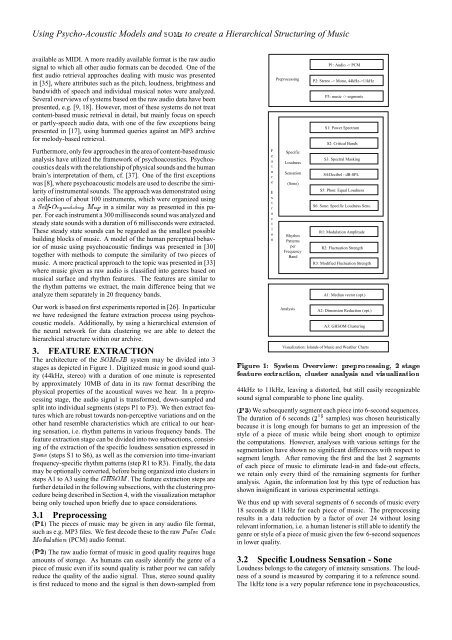


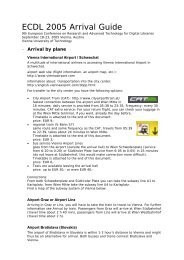
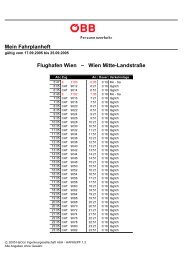
![Informationsvisualisierung [WS0708 | 01 ]](https://img.yumpu.com/22537403/1/190x143/informationsvisualisierung-ws0708-01-.jpg?quality=85)
